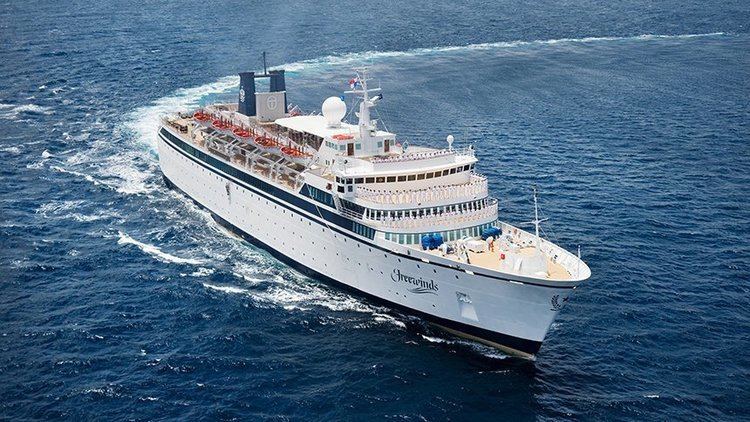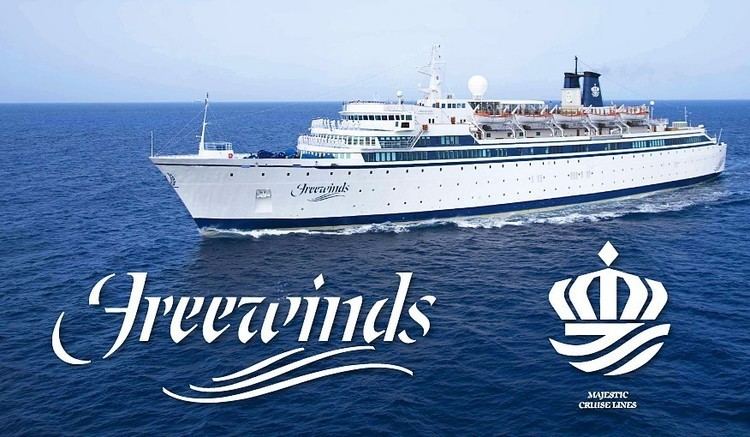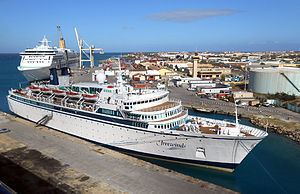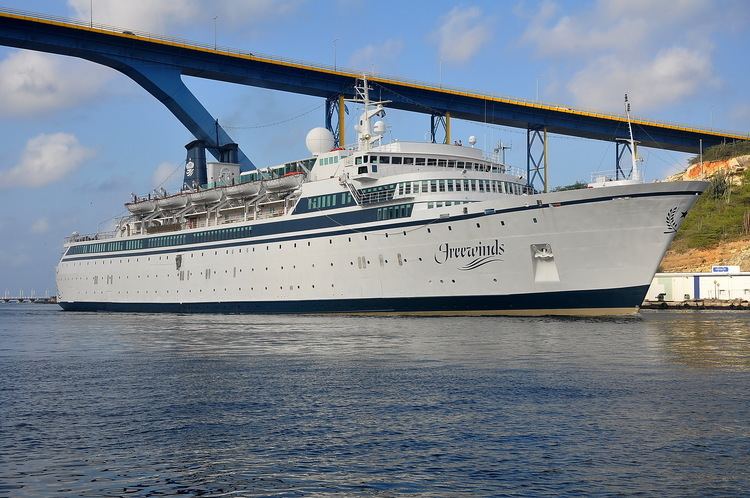Yard number 1161 Launched 12 February 1968 Beam 21 m | Acquired 12 November 1968 Length 134 m Builder Crichton-Vulcan | |
 | ||
Name 1968–1985 Bohème1985–onwards Freewinds Owner 1968–1981 Wallenius Bremen1981–1985 Hanseatic Caribbean Shipping Co1985 onwards San Donato Properties Corporation Operator 1968–1982 Commodore Cruise Line1982–1983 Saitecin Cruises1984 Commodore Cruise Line1984–1985 SeaEscape1985 Commodore Cruise Line1985 Majestic Cruise Lines Port of registry | ||
Scott campbell drugged and imprisoned on church of scientology ship freewinds 1 6
MV Freewinds is a cruise ship operated by International Shipping Partners and owned by San Donato Properties, which is a company affiliated with the Church of Scientology. It was built in 1968 by Wärtsilä Turku Shipyard in Turku, Finland for Wallenius Lines as MS Bohème for service with Commodore Cruise Line. It was the first cruise ship built in Finland. Its ownership passed to a Church of Scientology-controlled company in 1985.
Contents
- Scott campbell drugged and imprisoned on church of scientology ship freewinds 1 6
- Scientology freewinds tour
- Concept and construction
- 19681981 Wallenius Lines ownership
- 19811986 Rederi Ab Sally ownership
- 1986 onwards Scientology acquisition and ownership
- Scientology use
- Other uses
- Environmental issues
- Exterior design
- Interior design
- As Bohme
- As Freewinds
- References

Scientology freewinds tour
Concept and construction
The ship that eventually became known as the Freewinds was originally ordered by the Sweden-based Lion Ferry as the second in a pair of two car/passenger ferries for use on their new Bremerhaven (West Germany)–Harwich (United Kingdom) service, with provisions made for cruise service during the northern hemisphere winter season. The ships shared the same design as Finnhansa and Finnpartner, that were under construction for Finnlines at Wärtsilä Helsinki Shipyard at the time. The ships ordered by Lion Ferry were built at Wärtsilä's Turku Shipyard, and the first of them, Prins Hamlet, was delivered to her owners on 14 May 1966. However, the passenger demand on the Bremerhaven–Harwich route proved to be insufficient for two ships, and Lion Ferry cancelled the order for a second ship, which was to be named "Prins Albert".

Meanwhile, the newly founded Commodore Cruise Line was looking for ships to operate on cruises around the Caribbean. An agreement was reached where the build contract of the half-complete ship was sold to the Sweden-based Wallenius Lines, who would have the ship completed as a cruise ship, and following completion she would be chartered to Commodore Cruise Lines. Following their tradition of naming ships after operas, Wallenius decided to name the ship Bohème, after La bohème. Cabins were added in place of the car decks on the ship (although bow or stern doors were never fitted on her), and her superstructure was redesigned to better accommodate the need for sundeck space in the warmer climates. The Bohème was delivered to Wallenius Bremen, Wallenius Lines' West Germany-based subsidiary, on 12 November 1968. She was registered in West Germany, with Bremerhaven as her home port.
1968—1981: Wallenius Lines ownership

Following delivery the Bohème sailed to Stockholm, the location of Wallenius Lines' headquarters, for a presentation to invited guests. On departing Stockholm for Miami she carried her first paying passengers on board. Her maiden voyage was cut short however, as she hit an underwater cliff outside Dalarö in the Stockholm Archipelago. The cliff breached the ship's hull and fuel tanks. Lifeboats were used to evacuate all passengers from the listing ship, and three days later she was refloated and towed to the Finnboda shipyard in Nacka for week-long repairs. After the repairs she again left for Miami, this time without passengers.

On 7 December 1968 the Bohème left on her first cruise from Miami to Saint Thomas. During her first year in service the ship had notable problems with her air conditioning due to the shipyard's inexperience with building ships for the warm Caribbean climate. As a result, she returned to Europe in 1980, sailing to the Blohm + Voss shipyard in Hamburg, West Germany where the air conditioning system was rebuilt, an additional screw compressor as well as two freshwater generators were installed. Following the rebuild the Bohème re-entered service with an itinerary of Miami–Puerto Plata–Saint Thomas–San Juan–Cap-Haïtien–Miami. She followed the same itinerary around the year, becoming the first ship to offer around-the-year seven-night cruises from Miami. She was also the first cruise ship to call at Puerto Plata and the first to offer regular sailings to Cap Haitien.
1981—1986: Rederi Ab Sally ownership
In March 1981 Commodore Cruise Line, as well as the Bohème, were sold to the Finland-based Rederi Ab Sally. The new owners re-registered the Bohème to Panama, which resulted in most of the German officers resigning due to worsened working conditions. The resigned officers were replaced with Scandinavians. The following year the German deck and engine crews were replaced by Filipinos. Originally the new crew members were meant for Navarino, a former ocean liner (ex Gripsholm 1957) Sally had purchased for conversion into service with Commodore Cruise Line. However, after the Navarino was severely damaged due to capsising of the drydock, the conversion plans were abandoned. The crew already hired for the Navarino was transferred to the Bohème.

Between November 1982 and August 1983 the Bohème was chartered to the Brazilia-based Saitecin Cruises for cruises around South America. She also made one cruise from Miami under this charter. Following this charter the ship again returned to West Germany to be rebuilt, this time in Bremerhaven, where two new diesel generators were installed and much of the interior decorations replaced. While in Bremerhaven she also received a new external livery. On returning to service in 1984 the Bohème was placed on a new Miami–Port-au-Prince–Port Antonio–Grand Cayman–Coromuel–Miami itinerary. The schedule proved to be too tight to maintain, especially in poor weather conditions. With engine problems causing further problems, this itinerary only lasted until November 1984, when the ship was chartered to SeaEscape for their Miami–Freeport ferry service.

In February 1985 the Bohème returned to Commodore Cruise Line service. Her port of departure was changed to Saint Petersburg, Florida to better cater to the needs of Commodore's main clientele, the retired people living on Florida's west coast. The ship's new seven-day itinerary was Saint Petersburg–Key West–Port Antonio–Cozumel–Saint Petersburg. The new route proved to be short-lived, as the Bohème was sold to San Donato Properties Corporation in September 1986 for US$10 million, to be converted for use with the Church of Scientology.
1986 onwards: Scientology acquisition and ownership
In 1984, the Church of Scientology's parent body, the Church of Scientology International (CSI), decided to obtain a ship on which to deliver high-level Scientology courses. According to a statement by the Church,
CSI believed that an ocean-going vessel would be the most appropriate facility for ministering New OT VIII because this advanced level of religious service requires a completely safe, aesthetic and distraction-free environment and because L. Ron Hubbard, the religion's founder, had researched and ministered the first OT levels aboard a ship in the late 1960s. A ship therefore would have particular religious significance to Scientologists.
An entity called the Flag Ship Trust (FST) was formed in December 1985 with the aid of a $5 million donation from the International Association of Scientologists. In September 1986, the Flag Ship Trust purchased Bohème, renamed her Freewinds and refitted her to enable its use for Scientology purposes. The vessel was put into service in June 1988.
The ownership and management of the vessel was organized through a complicated web of Scientology-run corporations and entities, most of which are owned by the Flag Ship Trust. It is owned by San Donate Properties, a Panamanian corporation of which FST is the sole shareholder. Another FST-owned Panamanian corporation, Transcorp Services, owns the mortgage on the Freewinds. FSS Organization was a Netherlands Antilles corporation responsible for paying certain taxes on the vessel to the Netherlands Antilles authorities. Scientology courses are delivered aboard the vessel by the Flag Ship Service Organization (FSSO), in effect a floating branch of the Church of Scientology. Majestic Cruise Lines is a Panamanian corporation which operates the Freewinds, receiving payment from FSSO for the use of the ship. MCL Services is a corporation in the Netherlands Antilles that provides shore support and liaison services for Majestic Cruise Lines and FSSO from the home port of the Freewinds', Curaçao.
Following the Church of Scientology's controversial tax exemption agreement with the U.S. Internal Revenue Service in 1993, these arrangements were simplified. The responsibilities of the Majestic Cruise Lines were to be transferred to FSSO, with Majestic itself being dissolved, and FSS Organization being dissolved as it was no longer required for tax reporting purposes in the Netherlands Antilles. However, the Majestic company remains in existence and is still actively billing visitors to the Freewinds.
The Freewinds is the fifth ship to be owned by the Church of Scientology. The other four have been the Royal Scotsman (later the Apollo), the Enchanter (later the Diana), the Avon River (later the Athena), and the Nekambi, all of which have been scrapped, apparently. However, the nameplate of the Diana has been preserved and is on display aboard the Freewinds. The church also operated two World War II surplus ships during the late 1960s through the early 1970s. These were the Bolivar, a subchaser, and the T.S.M.Y. Excalibur. Both of these vessels were docked at San Pedro, California, and they were used for training new Sea Org members.
Scientology use
The Freewinds is the exclusive training center for OT VIII (Operating Thetan Level 8), the highest level of Scientology and the last of the published OT levels. Members of the Church of Scientology who have reached the highest levels must receive their training on the Freewinds, as the Church does not deliver this service anywhere else.
Besides the OT VIII training, the Freewinds is used for delivering lower-level classes and auditing services. She is also used as a recreational vessel for Scientologists. The ship hosts a "Freewinds Maiden Voyage" each June as an "OT Summit" for high-ranking Scientologists at which Scientology accomplishments and plans for the future are publicly celebrated.
A significant portion of the ship is given over to its use as a religious retreat for Scientologists. As well as various course rooms and a library of L. Ron Hubbard books, the Freewinds has areas given over to the Religious Technology Center, Sea Org and International Association of Scientologists. As is common practice in other Scientology organizations, the ship also has an "LRH Office" symbolically set aside for L. Ron Hubbard's use (Hubbard died in January 1986, approximately nine months before the vessel was purchased).
Valeska Paris, a former Scientology staff member on the ship, has alleged that she was held on the ship against her will and forced into manual labor for 12 years.
Other uses
The Freewinds often hosts local functions in the ports it frequents, such as jazz concerts and movie performances in Aruba, Bonaire and Curaçao. These events are usually free but often support island charities through entrance fees or suggested donations. Local artists are often showcased. It also caters to different international conferences and events. The ship's leisure facilities include a restaurant, lounge, cabaret, swimming pool, movie theater and beauty salon.
Environmental issues
In April 2008, the Freewinds was shut down after cancer-causing blue asbestos was discovered by government health inspectors during maintenance by the Curaçao Drydock Company. Blue asbestos is the most dangerous form of asbestos, and the ship is reported to be "extensively contaminated". According to InsuranceNewsNet, "Decontamination, if it is even possible, is likely to cost tens of millions of dollars and would result in the ship being in dry dock for many months."
The discovery confirmed a 2001 allegation by former Scientologist Lawrence Woodcraft, who had overseen the original renovation of the Freewinds in 1987.
The Captain also admitted that during previous maintenance performed by his personnel, asbestos was released into the ventilation system but not reported.
The Church of Scientology denied that there is an asbestos problem, commenting in May 2008 that "there is not now and never has been a situation of asbestos exposure on the Freewinds." Karin Pouw, spokesperson for the Church of Scientology, told Radar Magazine that the air quality on the ship was regularly tested and "always meets or exceeds US standards". The Church contracted Nordica Engineering to perform renovations on the Freewinds and denied the presence of blue asbestos during talks. To remove material from the ship, Nordica brought in 240 Polish workers, who lived on the Freewinds for a month and a half. When workers told Nordica there was blue asbestos on the ship, they stopped renovations and workers returned to Poland. Witold Maliński stated that Nordica was looking to demand compensation on behalf of its workers.
The Freewinds has been noted in Bonaire for the amount of waste water it dumps into the island's inland waste pit.
Exterior design
The exterior design of the Bohème/Freewinds is very similar to the Finnhansa class ships built as ferries. She has a moderately raked and slightly rounded bow, rounded forward superstructure, terraced rear superstructure and two slim side-by-side funnels. She differs from her sisters with the superstructure expanding further on promenade deck (on the other ships it only extends as far as the bridge), swimming pool added to the rear of promenade deck, and the observation lounge missing from the topmost deck; this was replaced by an open sunbathing area.
As built the Bohème was painted in Wallenius Lines livery, with an all-white hull and superstructure, yellow radar mast and yellow funnels with a wide horizontal green stripe painted on them and the letters OW (for Olof Wallenius) painted on the stripe. The ship only kept this livery until her first visit to Miami, where she was repainted in the Commodore Cruise Line livery, with white funnels and radar mast. A dark blue decorative stripe was later painted on the hull. During the 1983 refit the livery of the Bohème was more radically altered, when blue stripes were painted along the windows on main and promenade decks, as well as the bridge windows. The funnels were re-painted with a spray-shaped design in blue, red and yellow.
Following acquisition by the Church of Scientology the ship's external appearance was changed slightly from the final Commodore livery; the Freewinds received dark blue funnels with the Majestic Cruise Lines logo on them, while an intricate combination of Scientology-related symbols was painted on both sides of the hull (pictured on the right). Additionally three decorative ribands were painted on the side of the hull towards the rear.
Interior design
Members of the Wallenius family were heavily involved in the interior design of the Bohème. Margareta Wallenius in particular dedicated her interest to the interiors of the ship, having her say in the materials used and works of art brought in from promising artists in Paris. Reflecting the company tradition of naming ships after operas, all public rooms on board were originally named after themes related to Puccini's La bohème, the opera that had given its name to the ship itself.
Compared to her sisters built for ferry service, cabins were built on the planned car-deck on the B- and C-decks on the Bohème. The car decks had in fact been originally planned to accommodate temporary cabin modules during the winter when Lion Ferry, the company that had originally ordered the Bohème, planned to use her for cruising to the Canary Isles. Additionally a small gymnasium and cinema were added in place of cargo hold on D-deck. All stairways and public rooms were panelled in light Nordic woods, while the deluxe cabins received dark oak panelings. During the 1983 refit much of the original panelling was replaced either by colourful paintings or mirrors to give an increased sense of space. Similarly much of the upholstery and carpets were changed into cheerier colours.
As Bohème
Only including spaces accessible to passengers.
As Freewinds
Only including spaces accessible to passengers.
